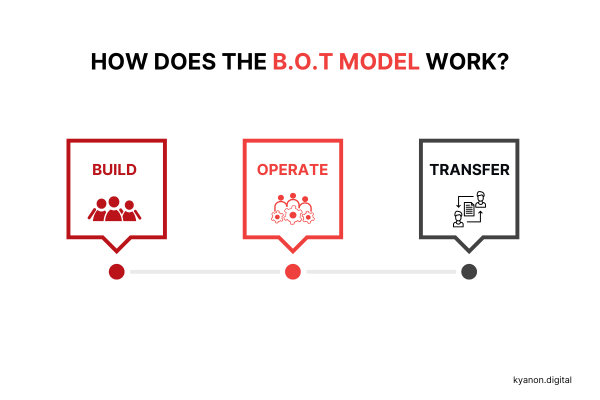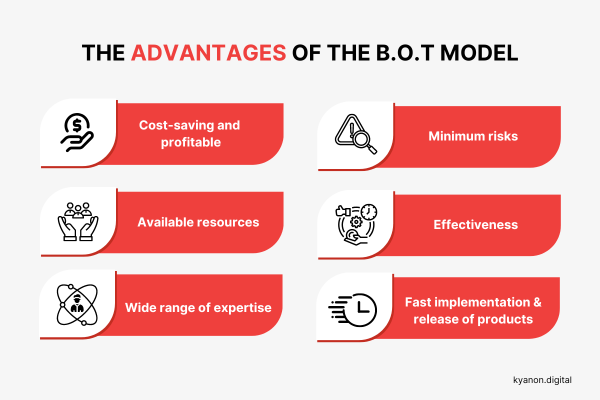In the modern world, IT software outsourcing is a strategy that has gained its popularity because the advantages it offers have brought improvements to business performance; however, there is an unavoidable presence of concerns regarding the loss of ownership, operational control or any possible damage. As a result, a Build Operate Transfer model – B.O.T team is considered as an efficient option to decrease the uncertainties to a minimum among a variety of IT outsourcing engagement models. In this article, Kyanon Digital will inform you of everything you need to know about B.O.T and the benefits this model presents to your business.
1. What is the B.O.T model?
According to Gartner, B.O.T team is defined as a contractual relationship in which an enterprise engages a service provider to build, optimize, and operate an IT or business process service delivery operation with the contractual intent to transfer the operation to the enterprise as an in-house operation. As a hybrid model, BOT includes aspects of both the “build” option (also known as “insourcing” or a captive center) and the “buy” option (commonly known as outsourcing; see also “captive centers”).
In software outsourcing, the B.O.T model is a strategy in which a software house establishes, enhances, and manages a fully operational software development center to a desirable degree of maturity. At this point, the customer receives a complete transfer of ownership.
Seeking a B.O.T team is an easy and effective method of software outsourcing, as they will be responsible for the functioning and operation of the solution. If there are any errors, the vendor will be the one who fixes it. Thereby, this strategy allows clients to minimize risks and prevents them from experiencing technical difficulties. At the final stage, they will gain a solution that is ready to function stably. Thus, this makes the model suitable for large intergovernmental deals as well as smaller partners.

2. How does the B.O.T model work?
The B.O.T model in software outsourcing is based on the following main phases: Build, Operate, and Transfer. These phases are conducted during the development and growth of the unit and in preparation for the transfer to the company.

2.1 Build
In this phase, the B.O.T service provider starts off with market research and in-depth analysis of the client’s capabilities, business goals, and requirements. Therefore, profound planning is required from both of you and your partnering organization. The primary processes include selecting a working location, forming a team, developing and implementing the IT infrastructure, and much more. The build stage also covers the team hiring procedure. Under the B.O.T model, your outsourcing partner will need to provide the legal framework within which the project will operate. They will also be responsible for the provision of hardware and a comfortable working environment for the staff.

2.2 Operate
During the operating stage, this is where the project’s management happens. The B.O.T team will handle everything, from working on product development to maintenance while providing technical support. Once everything is running smoothly, they perform the growth strategy and scale the project based on the plan. In addition, there is a great deal of team coaching and personal development that takes place until the ideal level of business maturity and technical capability is achieved. In most cases, there is a fixed period of time that this phase lasts.

2.3 Transfer
This is the final stage of B.O.T. At this point, the client receives ownership rights from the third-party vendor. It happens when the client company declares that they are capable of handling the project independently. Simply put, the transfer phase begins when the client organization is mature enough to undertake project responsibility.

3. The advantages of the B.O.T model
3.1 Cost-saving and profitable
B.O.T, like other outsourcing strategies, aims to reduce costs whenever practicable. By transferring the work involved in IT operation setup and maintenance to a third-party vendor, you can avoid the trouble of setting up an internal IT staff or investing in significant resources. This aspect alone has already made an outstanding contribution to saving a considerable amount of money that would otherwise be an investment or for employing more talented resources. The outsourcing company’s effective operations enable their partners to reduce operational expenses while increasing profitability.
3.2 Available resources
One of the most significant advantages of using the B.O.T project delivery mechanism is that you will not be under pressure of seeking resources, hiring software developers, and giving them the necessary software and hardware for project execution. It is the B.O.T team who will be responsible for providing necessary resources. Furthermore, the workforce is already knowledgeable of the focus industry and well-prepared to deal with any problems that may occur during the project.
3.3 Wide range of expertise
Organizations can access a variety of knowledge and technologies through B.O.T contracts that they might not otherwise have. This gives businesses a competitive advantage since they are able to apply advanced technology in their processes to provide services and products rapidly and efficiently. In addition, these vendors have access to talent pools with particular skills that may be inaccessible and unknown to customers. Thus, B.O.T as well as other outsourcing strategies are the best alternatives for coping with IT staffing shortages.
3.4 Minimum risks
When you cooperate with a B.O.T team, you will have a skillful team administering your project without having to seek and hire long-term employees. Their knowledge and cross-industry competencies will provide you the most suitable and efficient method for your project. Besides, before signing the contract, there would be comprehensive checks and evaluations to ensure your idea can be implemented profitably.
Not to mention, the partnering organization is knowledgeable of local regulations and laws where the project will develop. They have an understanding of faults that you are not aware of and might commit along the road. You may make the most of your investment and make the best legal decision by having your project undertaken by a B.O.business.
3.5 Effectiveness
Your B.O.T team can collaborate with your in-house team to add extra value to the project. The in-house team can share their experience and vision, which the B.O.T team will implement in the project. Although the B.O.T team will work independently, they will be engaged in your corporate culture. Also, regular communication sessions between your in-house and B.O.T team can be held to share progress, brainstorm ideas, and produce insights.
Additionally, a B.O.T team can be easily expanded if the project is in need of extra resources. Collaboration with existing in-house teams can be more effective since members of the BOT project team are completely integrated and have knowledge of the company culture.
3.6 Fast implementation and release of products
With the B.O.T contract, the client company receives assets and a workforce that can be put to immediate use. After the transfer, the business continues normally, or new products can be created. The team and infrastructure are sufficient, and the setup procedure is done. When the vendor assumes control of the project, they can easily deploy the necessary resources and technologies. This helps to prevent any potential delays caused by continual re-evaluation or renegotiation of contracts. Therefore, clients can launch their projects more quickly and have results sooner than anticipated.

In this article, Kyanon Digital has explained what B.O.T is and everything you need to know about this outsourcing model. It is a suitable and effective option for adding extra resources to IT projects while minimizing risks and responsibilities on your business. And if you have any questions related to this matter, do not hesitate to contact us for specific consultation.



